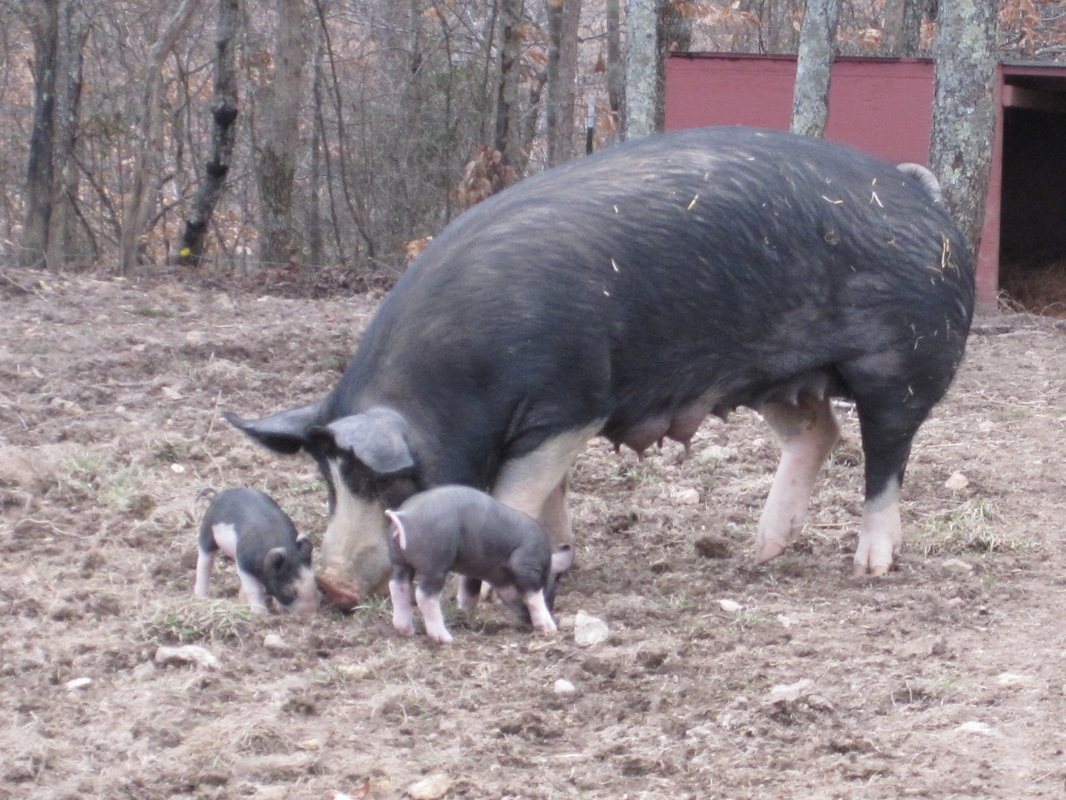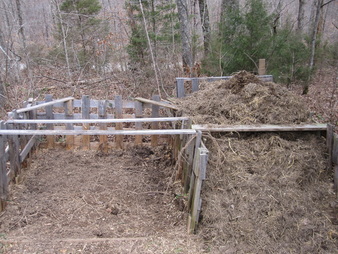Since the weather has been cooperative these last few weeks, we have been able to get some of our To Do list completed and get a jump on spring cleaning. We got another pasture fenced and pig house built so we could get everyone in a new or new to them pasture. We moved the two big pigs to the new pasture we just completed, then moved the six growing pigs to the other large pasture and moved Rocky and her two wee piglets out of the barn to the nursery pasture. Everyone seemed to enjoy exploring their new accommodations.
The two newest piglets are hanging in there and seem to be growing well. Surprisingly, one of the two survivors is the runt, who likely would not have survived with the competition of more piglets. Rocky has become a good mother and keeps a close eye on her little ones; calling to them if they stray too far from her.
One of our first projects when we moved to the farm two years ago was to build two large compost piles. We got scrap wood crates from Tractor Supply for free, so they only cost us a few dollars in screws. They aren’t pretty but they get the job done. We only use one at a time, so one is resting while we fill the other. It takes us about six months to fill each one, so by the time the active one is full, the resting one has had time to compost. This weekend I had to empty the finished one out and I managed to get about 1000 pounds of compost to use in my nine raised garden beds. This should be almost enough to have them ready for spring and it saved us at least $50 over the price of bagged compost. As an added bonus, the compost was so full of worms, the chickens got to enjoy a small feast when I gave them a handful. The rest went into the garden beds to work their magic.
I love that nothing goes to waste here on the farm. I really enjoy the complete sustainable cycle; we grow it and if we don’t eat it, it goes to the chickens or pigs, if they can’t eat it, it goes to the compost, where it breaks down and goes back into the garden to grow the produce the next year. And so it begins again.
The two newest piglets are hanging in there and seem to be growing well. Surprisingly, one of the two survivors is the runt, who likely would not have survived with the competition of more piglets. Rocky has become a good mother and keeps a close eye on her little ones; calling to them if they stray too far from her.
One of our first projects when we moved to the farm two years ago was to build two large compost piles. We got scrap wood crates from Tractor Supply for free, so they only cost us a few dollars in screws. They aren’t pretty but they get the job done. We only use one at a time, so one is resting while we fill the other. It takes us about six months to fill each one, so by the time the active one is full, the resting one has had time to compost. This weekend I had to empty the finished one out and I managed to get about 1000 pounds of compost to use in my nine raised garden beds. This should be almost enough to have them ready for spring and it saved us at least $50 over the price of bagged compost. As an added bonus, the compost was so full of worms, the chickens got to enjoy a small feast when I gave them a handful. The rest went into the garden beds to work their magic.
I love that nothing goes to waste here on the farm. I really enjoy the complete sustainable cycle; we grow it and if we don’t eat it, it goes to the chickens or pigs, if they can’t eat it, it goes to the compost, where it breaks down and goes back into the garden to grow the produce the next year. And so it begins again.


 RSS Feed
RSS Feed
